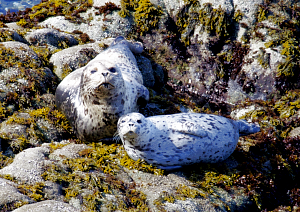Harbor Seals | Watch Harbor Seals at Fort Ross

What do they look like?
Harbor seals are earless seals (Phocids) and are on average 5-6 feet long and weight 200–300 pounds. With few sexual differences, male and female Harbor Seals have short flippers, small earholes and a coarse fur coat that lacks insulation that they receive from a thick layer of blubber. Their fur has a mottled coloration that varies in color from brown to silver or spotted black. Some seals are red from iron oxide on their fur. The origin of this is unknown, but some theorize it comes from the iron-rich sediments where they capture prey.
Fort Ross Harbor Seal Survey Instructions, by Jamie Hall
Harbor Seals at Fort Ross – locations and photos
Feeding and Behavior
Harbor Seals typically live in estuaries or near shore, in rocky or soft bottoms areas. They rarely go more than twelve miles from shore and have been known to travel up rivers when pursuing prey. Because they lack maneuverability on land, their preferred haul out sites are low or sloped rocks. It is also important that they choose sites with wide visibility to see predators. Harbor Seals are generally considered non-migratory, but there is significant mixing of individuals among colonies outside of the breeding season.
Foraging in groups of up to 25, Harbor Seals feed on the species abundant in the area, mainly schooling fish, cephalopods, and crustaceans. The average dive for food is only 16 feet, but dives up to 1,640 feet have been recorded. Foraging at night and resting during the day, Harbor Seals eat about 4-8% of their bodyweight in food every day.
Pupping season
At Fort Ross, breeding season takes place in May and June, followed by an annual molting. The seals in more southern areas breed in the earlier part of the season, with northern seals following later in the summer. For added warmth, pups born with an extra fur coat called lanugo. Mature females give birth annually to one pup that can swim at birth, and nurse for 30–45 days.
Population Threats and Conservation
Harbor Seals are killed mainly by great white sharks, but also by Steller Sea Lions and Killer Whales. While the general range of harbor seals has not changed since prehistoric times, individual sites have been abandoned because of large amounts of human disturbances like small boats, noise, dogs, and low-flying aircraft. Populations seem to have declined in the Gulf of Alaska since the 1980’s, but steadily, slowly increasing in California.
Main Sources:
Allen, Sarah G., Joseph Mortenson, and Sophie Webb. “Harbor Seal.” Field Guide to Marine Mammals of the Pacific Coast: Baja, California, Oregon, Washington, British Columbia. Berkeley: University of California, 2011. 431-42. Print.
“Harbor Seal (Phoca Vitulina).” NOAA Fisheries Office of Protected Resources. N.p., 11 June 2013. Web. 07 Oct. 2013.